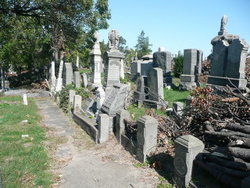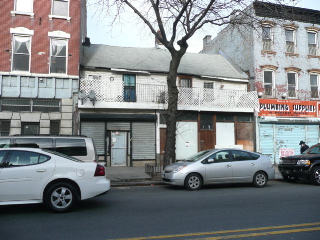Dora immigrated to New York in May, 1878, after her husband died. She traveled by herself from Hamburg, Germany, by way of Le Havre, France, on the steam ship Lessing. She had a betweendeck ticket, which refers the steerage part of the ship where the poorer immigrants were accommodated.
Dora moved in with Isaac and Sarah Laventhall and their two infant children, and lived with them for the rest of her life. They were probably then living in an apartment at 138 Orchard Street. By 1880 the family was living at 91 Hester Street, and the next year moved to nearby 455 Grand Street, where they lived for about 7-8 years in an apartment on the second floor.
This was the heart of New York City's Jewish ghetto of the Lower East Side. The author Abraham Cahan featured this area in his 1896 novel Yekl: A Tale of the New York Ghetto, which was the basis of the 1974 film Hester Street. In the book, Jake, a cloak-maker, goes for a walk after work one evening:
"He had to pick and nudge his way through dense swarms of bedraggled half-naked humanity; past garbage barrels rearing their overflowing contents in sickening piles, and lining the streets in malicious suggestion of rows of trees; underneath tiers and tiers of fire escapes, barricaded and festooned with mattresses, pillows, and featherbeds not yet gathered in for the night. The pent-in sultry atmosphere was laden with nausea and pierced with a discordant and, as it were, plaintive buzz. Supper had been despatched in a hurry, and the teeming populations of the cyclopic tenement houses were out in full force "for fresh air," as even these people will say in mental quotation marks. Suffolk Street is in the very thick of the battle for breath. For it lies in the heart of that part of the East Side which has within the last two or three decades become the Ghetto of the American metropolis, and, indeed, the metropolis of the Ghettos of the world. It is one of the most densely populated spots on the face of the earth - a seething human sea fed by streams, streamlets, and rills of immigration flowing from all the Yiddish-speaking centers of Europe. Hardly a block but shelters Jews from every nook and corner of Russia, Poland, Galicia, Hungary, Roumania; Lithuanian Jews, Volhynian Jews, south Russian Jews, Bessarabian Jews; Jews crowded out of the "pale of Jewish settlement"; Russified Jews expelled from Moscow, St. Petersburg, Kieff, or Saratoff; Jewish runaways from justice; Jewish refugees from crying political and economical injustice; people torn from a hard-gained foothold in life and from deep-rooted attachments by the caprice of intolerance or the wiles of demagoguery - innocent scapegoats of a guilty Government for its outraged populace to misspend its blind fury upon; students shut out of the Russian universities, and come to these shores in quest of learning; artisans, merchants, teachers, rabbis, artists, beggars - all come in search of fortune."
In 1887 Isaac Laventhall was still working as a shoemaker in the Lower East Side. Within the next year or two he had made two dramatic changes. First, by 1889 the family moved to 649 Myrtle Avenue (see photo), a two-story frame house in Brooklyn. Second, Isaac changed his occupation from shoemaker to cigar dealer, and his business prospered.
Dora celebrated her 80th birthday in 1899. At the turn of the century the family living at 649 Myrtle Avenue consisted of Dora, her daughter Sarah and son-in-law Isaac, and her grandchildren David, a 25 year old clerk, Teddy, a 22 year old music teacher, and Max, a 16 year old clerk. Dora died at home on June 30, 1901.
Dora immigrated to New York in May, 1878, after her husband died. She traveled by herself from Hamburg, Germany, by way of Le Havre, France, on the steam ship Lessing. She had a betweendeck ticket, which refers the steerage part of the ship where the poorer immigrants were accommodated.
Dora moved in with Isaac and Sarah Laventhall and their two infant children, and lived with them for the rest of her life. They were probably then living in an apartment at 138 Orchard Street. By 1880 the family was living at 91 Hester Street, and the next year moved to nearby 455 Grand Street, where they lived for about 7-8 years in an apartment on the second floor.
This was the heart of New York City's Jewish ghetto of the Lower East Side. The author Abraham Cahan featured this area in his 1896 novel Yekl: A Tale of the New York Ghetto, which was the basis of the 1974 film Hester Street. In the book, Jake, a cloak-maker, goes for a walk after work one evening:
"He had to pick and nudge his way through dense swarms of bedraggled half-naked humanity; past garbage barrels rearing their overflowing contents in sickening piles, and lining the streets in malicious suggestion of rows of trees; underneath tiers and tiers of fire escapes, barricaded and festooned with mattresses, pillows, and featherbeds not yet gathered in for the night. The pent-in sultry atmosphere was laden with nausea and pierced with a discordant and, as it were, plaintive buzz. Supper had been despatched in a hurry, and the teeming populations of the cyclopic tenement houses were out in full force "for fresh air," as even these people will say in mental quotation marks. Suffolk Street is in the very thick of the battle for breath. For it lies in the heart of that part of the East Side which has within the last two or three decades become the Ghetto of the American metropolis, and, indeed, the metropolis of the Ghettos of the world. It is one of the most densely populated spots on the face of the earth - a seething human sea fed by streams, streamlets, and rills of immigration flowing from all the Yiddish-speaking centers of Europe. Hardly a block but shelters Jews from every nook and corner of Russia, Poland, Galicia, Hungary, Roumania; Lithuanian Jews, Volhynian Jews, south Russian Jews, Bessarabian Jews; Jews crowded out of the "pale of Jewish settlement"; Russified Jews expelled from Moscow, St. Petersburg, Kieff, or Saratoff; Jewish runaways from justice; Jewish refugees from crying political and economical injustice; people torn from a hard-gained foothold in life and from deep-rooted attachments by the caprice of intolerance or the wiles of demagoguery - innocent scapegoats of a guilty Government for its outraged populace to misspend its blind fury upon; students shut out of the Russian universities, and come to these shores in quest of learning; artisans, merchants, teachers, rabbis, artists, beggars - all come in search of fortune."
In 1887 Isaac Laventhall was still working as a shoemaker in the Lower East Side. Within the next year or two he had made two dramatic changes. First, by 1889 the family moved to 649 Myrtle Avenue (see photo), a two-story frame house in Brooklyn. Second, Isaac changed his occupation from shoemaker to cigar dealer, and his business prospered.
Dora celebrated her 80th birthday in 1899. At the turn of the century the family living at 649 Myrtle Avenue consisted of Dora, her daughter Sarah and son-in-law Isaac, and her grandchildren David, a 25 year old clerk, Teddy, a 22 year old music teacher, and Max, a 16 year old clerk. Dora died at home on June 30, 1901.
Family Members
Sponsored by Ancestry
Advertisement
Explore more
Sponsored by Ancestry
Advertisement






